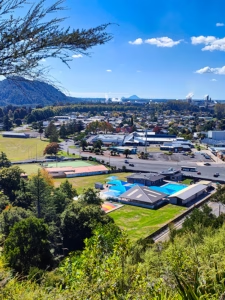
Kawerau, located in the heart of the Bay of Plenty, is a town with a rich history rooted in its natural resources and strong sense of community. The area has long been significant to Māori, particularly the local iwi (tribe) of Tuwharetoa ki Kawerau. This iwi have treasured the region’s geothermal activity, fertile lands, and abundant waterways for centuries, utilizing them for food, warmth, and sustenance.
In the mid-20th century, Kawerau emerged as a vibrant town following the establishment of the Tasman Pulp and Paper Mill in 1953. This development attracted workers and their families from across New Zealand and abroad, creating a thriving and multicultural community. The town quickly became known for its strong workforce and connection to forestry, a cornerstone of New Zealand’s economy.
Kawerau has always embraced its natural surroundings, with the majestic Mount Putauaki (Mount Edgecumbe) standing as a guardian over the town. Residents and visitors enjoy outdoor activities such as free heated swimming pools and spa, beautiful parks, hiking, fishing, mountain biking as well as world class kayaking which celebrate the area’s geothermal features and lush environment.
In recent decades, Kawerau has focused on diversification, welcoming new industries and events that highlight its creativity and resilience. Community festivals like the Kawerau WoodFest showcase local talent, while initiatives in sustainable forestry and energy reflect the town’s innovative spirit.
Today, Kawerau is recognized for its strong sense of community, cultural pride, and natural beauty. Its warm-hearted people and forward-thinking initiatives continue to shape a promising future while honoring its rich history and unique place in New Zealand.

An insight into some early Kawerau residents
Bert Immink -A Dutchman in Germany during World War II